7 Best Passive Income Ideas to Make Real Money in 2024
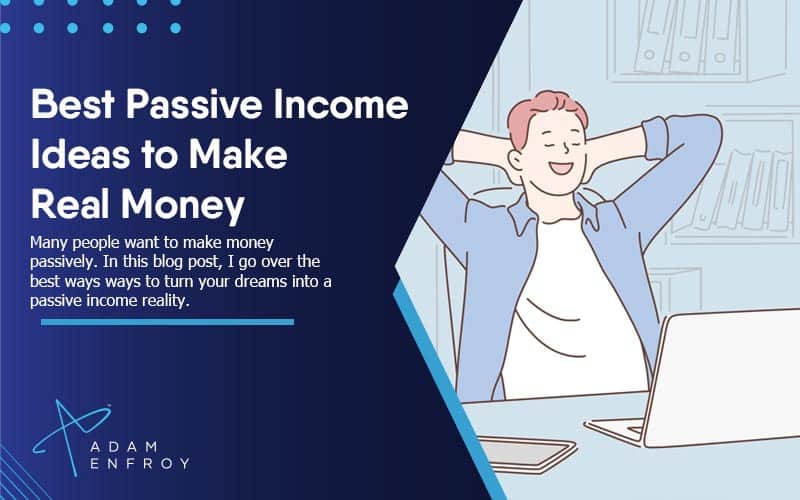
Want to jump to one of the best ways of making passive income? Check out ArrivedHomes, a solution that allows you to buy property shares and make money in return.
Today, the dream of making passive income bombards you everywhere – Facebook Ads promising instant wealth. Instagram influencers touting some new strategies.
YouTube ads with some shirtless guy in his garage, spewing nonsense about making millions on Shopify.
Here’s the truth:
Passive income is never totally passive.
I built this blog to a $100k/month business, but it took real work to get there.
When considering your digital marketing strategy for passive income, you’re usually selling one of three things:
- Your own products (ecommerce).
- Someone else’s products (affiliate marketing).
- Your time (coaching and consulting).
In this guide, we’ll cover the three key principles you need to follow (no matter what you’re selling) in order to make money online.
We’ll also cover the best ways to generate passive income along with ideas and strategies that work this year.
Check out my video on the best passive income ideas:
Let’s get started.
Disclaimer: This article includes affiliate links that may provide a small commission to me at no cost to you. However, these are the best tools to help you gain passive income this year. You can read my affiliate disclosure in my privacy policy.
What is Passive Income?
Passive income, by definition, is earning money from a partnership, enterprise, or rental property in which you are not actively involved.
However, the definition has changed over the years to include money earned online that takes little or no effort to make.
For example, dividends and interest (portfolio income) is considered passive income.
One can also consider apps such as Arrived Homes that helps you get started with real estate investment by allowing you to buy shares of a rental property you like.
In its looser definition, passive income could also be something like affiliate marketing income earned through this blog – while I put in a lot of work upfront, I don’t have to actively do anything anymore to make it.
The 4-Hour Workweek by Tim Ferriss propelled this idea into the mainstream, and Pat Flynn’s Smart Passive Income elevated it further.
What Are the Best Passive Income Ideas?
Today, when many think of passive income, they think of digital entrepreneurship: selling digital products, affiliate marketing, online courses, Google AdSense, selling eBooks, etc.
There are also traditional routes to passive income like real estate investment trusts, licensing, and dividends from the stock market.
We’ll cover both in this guide.
Here are my top passive income ideas and strategies to try this year.
1. Start a Blog (or Online Business) the Right Way.
I’m starting this guide with blogging as a passive income strategy because I believe from experience that it is the #1 way to make passive income.
Whether you want to make $1000 a day, more, or less, a blog is the most passive type of online business.
The revenue comes in from three passive income streams:
- Affiliate revenue: commissions I generate when readers click one of my affiliate links and purchase a product from a company.
- Ad revenue: Mediavine ads that pay out monthly.
- Digital product sales: paid products that are downloaded and don’t require any shipping.
So how do you get started?
When you think about starting a blog, you could be tempted to pick a passion of yours and start writing content.
However, modern-day blogging isn’t necessarily all about writing – it’s about running your blog like a business.
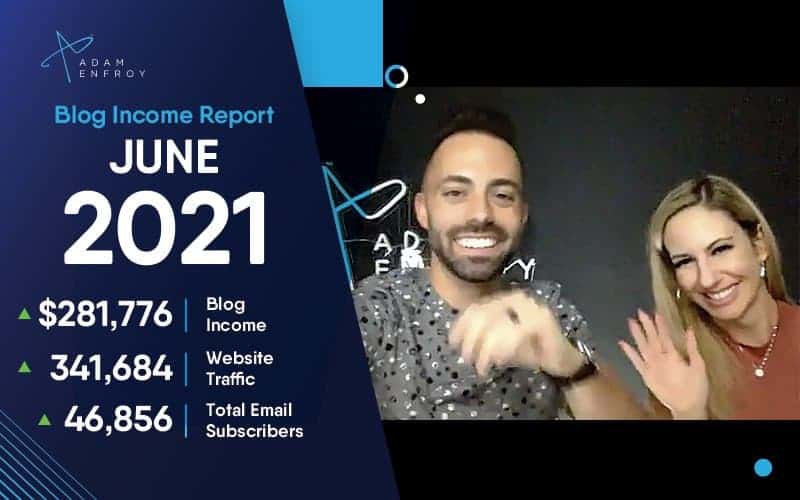
Let me explain.
To make a full-time passive income from blogging, you need to mentally transition from being just a blogger to being a business owner.
This psychological shift allows you to see things from a different perspective – you aren’t blogging as a hobby but are creating systems to scale your blog as an online business.
First, you need to understand the correct ways to monetize a blog based on the lifecycle and age of your blog.
You can read all of my in-depth strategies in my 15,000+ word, ultimate guide to starting a profitable blog.
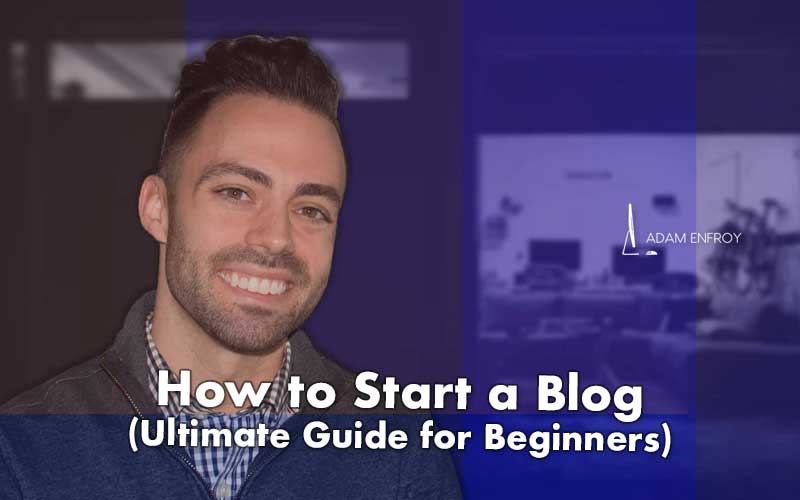
Why Are Bloggers Failing?
As many as 95% of bloggers fail.
Many “experts” claim that bloggers are failing because they aren’t passionate enough or can’t stay consistent with their writing.
This isn’t the case.
The truth is: 95% of bloggers fail because they can’t make it profitable.
I’m passionate about a lot of things – running, astronomy, fantasy football, Breaking Bad, personal development – but if I had to write about these topics for years and never made a cent, I’d quit 100% of the time.
So how do you create a profitable blog?
Choose Your Blog’s Niche with Revenue in Mind.
Most bloggers start with a passion in mind, write passionately for years, but don’t know how to transition from blogger to profitable blogger. Revenue is put on the back-burner to be figured out “one day.”
Instead, it needs to be planned from day one.
How does this factor into niche selection?
Take this example.
Let’s say you’re passionate about teaching, and you start a blog about productivity and time management for college students.
You just chose your niche site idea based on passions rather than revenue potential.
A college audience isn’t the most lucrative. Back when I was in college, I was lucky to have over $100 in my bank account. I was more interested in buying beer than a digital product from a blogger.
However, if you change your niche slightly, you can reach a much more lucrative audience.
Instead of tips for college students, what if you focused instead on learning management systems and tips for the universities themselves?
Here, instead of selling to college students, you’re selling to professors and administrators and could make money via:
- Affiliate marketing: write about the best learning management systems or video conferencing software.
- Consulting: sell your time as an eLearning expert.
With both approaches, the content is similar, but one audience has much more money to spend on the solutions you’re solving.
Keyword Research
The next step is to determine if people are searching for what you’re writing about.
Your niche needs market demand, and this is discovered through keyword research.
One great tool for the execution of your keyword research is Ahrefs.
With their keyword tool, you can search for different keyword ideas and see how many times people search for them on Google each month.
You can also view keyword difficulty.
This score indicates the relative competition for that keyword on a scale from 0 to 100. Try to find keywords with a difficulty score under 50.
Overall, here are the main metrics to track to research the market demand and viability of your blog’s niche:
- Monthly searches for the keyword should be over 1,000.
- The keyword difficulty of the keywords should be less than 50.
- The search engine results for the first page should have one website with a Domain Rating (DR) under 50.
- The top 5 search engine results should have changed slightly in the last six months.
Build Relationships with Other Bloggers.
After you choose your blog’s niche, launch your blog with Bluehost and WordPress, the biggest thing to focus on is real-world relationships.
Create your first five blog posts and stop writing.
Instead, focus on building real relationships with other bloggers to get backlinks and guest posting opportunities. You can read my full guide on the importance of guest blogging and how it helps build your Domain Authority.
This approach helped me to gain over 3,000 backlinks from over 500+ domains in my blog’s first six months.
Also, remember that we are aiming to build valuable links. This is why the DA of the website we want to link back to us matters as well.
By focusing less on writing and more on generating backlinks, you can build search engine authority and get more traffic to your website.
If you don’t consider yourself to be a good writer, you can outsource all parts of the process – both for your own site and the guest posting.
There are those that outsource their content strategy and the content creation process, finding writers that get the job done.
In addition, from the people that outsource their content creation, 35% outsource their content distribution as well, ensuring that their links end up all over the internet.
This goes to show that you can always find experts who can do specific jobs better while freeing up your time.
Monetize Your Website.
For the first three months of your new blog, focus primarily on building up your blog’s Domain Authority. This approach helped my blog go from 0 to 18,000 organic site visitors per month in 90 days and 44,000+ in 6 months:
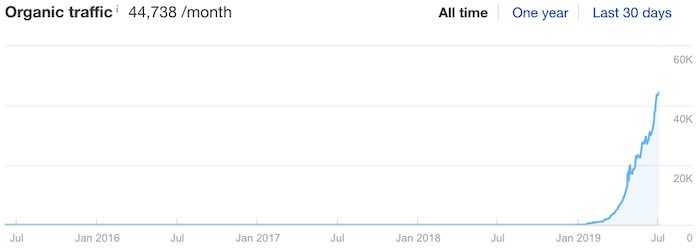
Then this number accelerated to over 125k within 11 months:
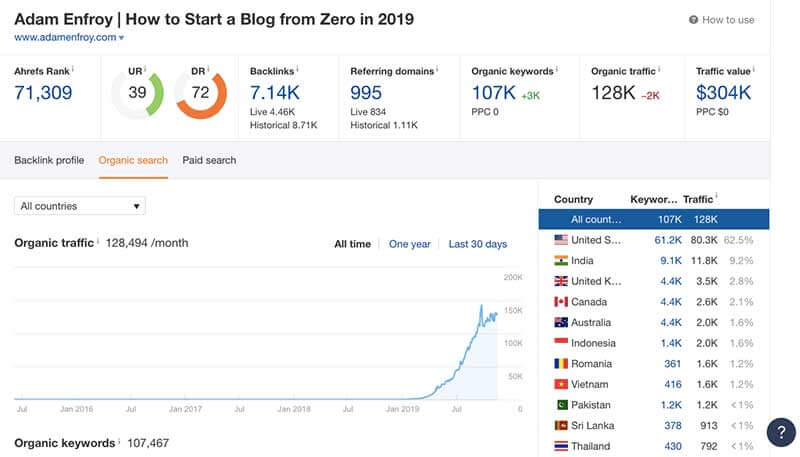
And 288k shortly after that:
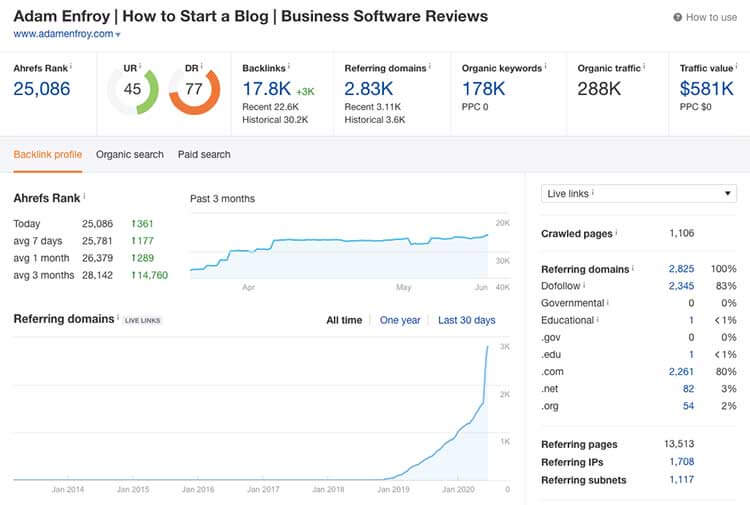
Ultimately, to make passive income with a website or blog, you need to follow three main steps:
- Launch: Choose a lucrative niche, create your content, and launch your website.
- Grow: Build links to your website to increase your search engine authority and get traffic.
- Monetize: Add affiliate links and ads to your website to monetize your traffic.
The first step on any blogging journey is getting a domain name and WordPress hosting.
From my experience, I recommend you go with Bluehost for $2.95/month. Bluehost offers all of the features needed to create a secure, reliable, and fast blog on WordPress.
Let’s move onto the next passive income ideas.
2. Investing.
Mastering personal finance is the key to growing wealth.
I wasn’t taught any of this in school.
In fact, I left college with student loans, a degree I didn’t know how to use, and virtually no savings.
And for years, I didn’t have strong financial goals. I was simply working to build an emergency money market fund and putting the bare minimum into my 401k.
However, with the success of this blog came a crash course on investing and building wealth.
Here are some tips if you want to make passive income investing.
Real Estate Investing.
A popular form of passive income generation is real estate investing.
This is done by leveraging real estate as a passive income source and using these income investments as a means to gain financial freedom with a cash flow outside of your job.
Whether you take part in “buy and hold” real estate investing, or even a real estate investment trust (REIT), there are plenty of ways to make good returns.
Take for example ArrivedHomes, a solution that allows you to invest in real estate without the usual hassle that comes with this process.
You don’t even have to take care of maintenance and paperwork – they take care of everything required.
All you need to do is buy shares of properties and leave the rest up to them.

These are some of the features that this platform offers:
- Consistent Passive Income so that you can live the life you want. This can allow you to live the life you want and not have to worry about working a traditional 9-to-5 job.
- Property Appreciation: Another advantage of investing in rental homes is that the value of the property often goes up over time. This can provide you with an increased return on your investment.
- Save Time & Energy: When you invest in rental properties, you can save yourself a lot of time and energy. You won’t have to worry about finding tenants, collecting rent, or dealing with any of the other hassles that come along with being a landlord.
- Tax Advantages: Investing in rental homes can also provide you with some great tax advantages. For example, you may be able to deduct your mortgage interest and property taxes from your income taxes.
- Diversify with Real Estate: Investing in rental homes can also help you to diversify your investment portfolio. This is important because it can help to protect you from any potential downturns in the stock market.
- Flexible Investment Amounts: Another great thing about investing in rental properties is that you can start with a small or large investment amount. This flexibility makes it easy to get started, even if you don’t have a lot of money to invest.
If you want to get started with real estate as a means of passive income, then ArrivedHome is definitely a great resource to check out.
Here are some tips to use real estate investing as a passive income stream:
- Do your research and invest in up-and-coming, safe neighborhoods close to where you live.
- Purchase single-family homes and condos in the $100k – $150k range that are easy to rent out.
- Research and hire a property management company to actively perform most landlord duties.
- Put 20% down instead of buying real estate properties with 100% cash. This allows you to purchase more properties quicker and you can use rental income to increase your cash flow.
- Take your excess rental income and start paying down mortgages with the snowball effect.
Index Funds
Investing in index funds is one of the best “buy and hold” strategies for new investors. Index funds are a type of mutual fund with no active management and much lower expense ratios.
They also usually have a pretty low minimum investment of around $3,000.
Index funds can be a collection of holdings in different companies that diversify your risk compared to individual stocks.
One of my current favorites is the Vanguard Growth Index Fund Admiral Shares (VIGAX). It’s made up of 33% tech stocks, with its top holding being big winners this year like Amazon, Microsoft, Apple, and Facebook.
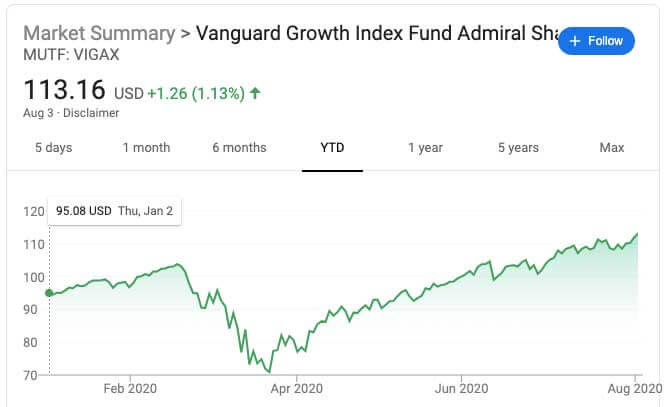
If you bought VIGAX at the beginning of 2020, your investment would have grown by 12% (as of August 2020). And if you bought VIGAX at the bottom of March 16, 2020, your passive investment would have grown by 55%.
You can also look into ETFS, which is an exchange-traded fund, for various investing options as well as mutual funds for better diversity.
Stocks
Stocks, or ownership shares of a company, are higher risk/reward than index funds because you’re buying into one individual company (and not a collection of holdings).
While they are riskier than index funds and bonds, they should also make up a portion of your passive income portfolio.
Most financial advisors tell you to manage risk by holding a percentage of equities in your portfolio equal to 100 minus your age.
So if you’re 30, you should hold 70% dividend stocks/equities and 30% bonds and safe assets.
If you have an emergency fund and can handle more risk, see if you can increase that percentage.
Cryptocurrency
With various crypto exchanges and trading platforms available, investing in crypto is easier than ever before.
These types of passive income are pretty volatile and do pose levels of risk, however, if you’re in it for the long-term, holding on to these assets can return a great return on your investment – all passively.
Other Forms of Investing
You can also bring automation into your passive income generation with Robo-advisors. These AI-based platforms balance your portfolio and manage risk for you.
Certificates of Deposit (CDs) are also a good opportunity for those seeking safe, low-risk residual income. The fact that interest rates in CD are locked-in regardless of the volatility in interest rates makes it more interesting.
While not widely used, there are great investment opportunities using lending clubs brokerage.
Short term business loans, peer to peer lending sites, and social media trading platforms are worth looking into.
Here, you might be able to help borrowers out with the money you have.
In exchange, they make your passive income dreams as a lender a reality.
When it comes to investing, always consider the financial institution to report to in your state.
For example, the internal revenue service (IRS) should always be kept in mind before making any type of investment.
3. Start an Online Course.
Over the last five years, we saw a major shift in the digitization of education. And with social distancing and eLearning skyrocketing, it’s a great time to create and sell online courses.
This passive income idea follows the same principles of launch, grow, monetize as above, but will rely on online courses as the main monetization strategy.
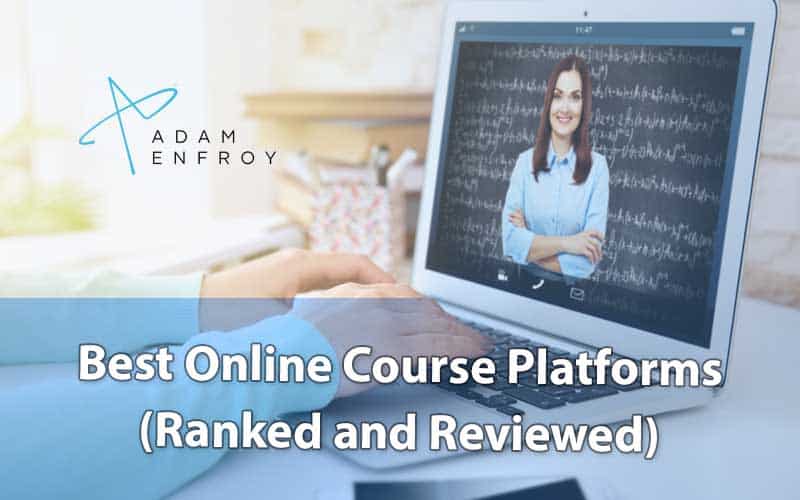
If you have a depth of knowledge to share, people will listen to you and pay for your expertise.
And you don’t need a Ph.D. to begin your online class – just a strong background in a topic you care about.
Additionally, students are even using tools to help them with academic coursework and papers, so online courses don’t have to only be video classes.
Courses can also include worksheets, homework, guides, and written tutorials. The options are endless.
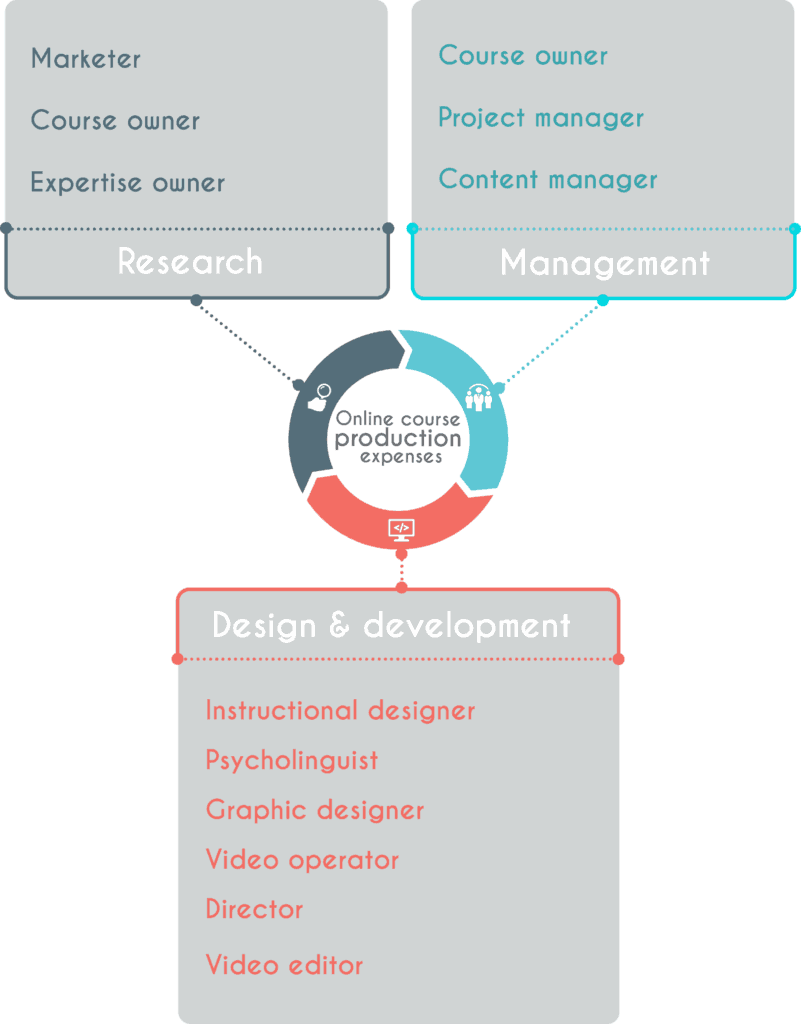
Source: racoongang.com
The first question to ask yourself is: “What problem is my course solving?”
The second question is: “Will people spend money on my solution?”
If so, you’re on the right track.
The online course platform you choose should allow you to manage the full education process. It should also integrate with other solutions like MailChimp and Google Analytics.
There are many great platforms like Teachable, Podia, Ruzuku, and many others.
Ultimately the online course platform I recommend is Thinkific.
Planning Your Online Course.
First, you have to prepare your course outline and content plan. How will your course transform your audience when they are done going through it?
After you plan your outline, break it up into 10-minute video segments that you can create.
Before getting too deep into course creation, it is smart to pre-sell your course to your audience.
Gauge interest, send them to a pre-sales landing page, and see if they click that buy button.
While asking your readers if they would buy the course can gauge some interest, nothing is more accurate than actually tracking pre-sales.
Your course’s price is also an important decision when launching. Premium courses sell anywhere from $499 to $1,999. Your price will depend on your audience’s needs and how in-depth you are going to go with the content.
A good baseline is to aim between $199 and $499 when starting out.
To launch your online course, get started with Thinkific, get your video equipment, screen-share software, microphone, editing software, and shooting location.
Once shot, edited, and uploaded, it’s time to promote your course.
Make sure to funnel your welcome email series into your online course offering, and feature it on your blog. You can also share your course on social, create an affiliate program for your course, and test paid social advertising.
When to launch: 6 months after you launch your blog, within six months, you should have enough traffic and an extensive enough email list to move from high-end $2,000-3,000 consulting sales to a $199 – $499 online course.
You’re one step closer to passive income.
Let’s move onto the next passive income idea.
4. Affiliate Marketing.
Again, this passive income idea is reliant on following the above steps to create a successful blog. When planning your content strategy, think of the high paying affiliate programs that you could be a part of.
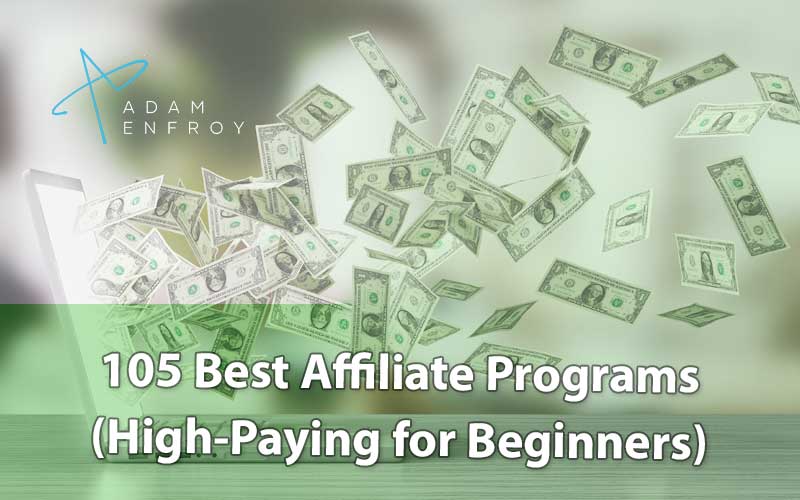
There are tons of affiliate programs in virtually every niche – the key is to find the best ones that pay the most.
Affiliate marketing is a numbers game.
Take this exercise as an example.
- Let’s say you rank for “best sandals for men” and get 1,000 visitors to your article.
- Of those 1,000 visitors, 20% click one of your affiliate links (200).
- Of that 200 left, 2% decide to purchase a pair of sandals (4).
- The sandals cost $50 each and your affiliate program’s commission is 7%. ($200 * 7%)
- You make $14.
Not much at all when you think about it.
Take this example instead.
- You rank for “best treadmills for runners” and get 1,000 visitors to your article.
- Of those 1,000 visitors, 20% click one of your affiliate links (200).
- Of that 200 left, 2% decide to purchase a pair of sandals (4).
- The treadmills cost $1,499 each and your commission is 12%.
- This time, you make $719.
Much more valuable, right? In fact, it’s 51x more valuable than the first example.
This is where affiliate marketing research comes into play. When selecting your website’s niche, research which affiliate programs have strong commission rates so that you can monetize your traffic faster.
You can also add affiliate links to different types of content – blog posts, emails, YouTube descriptions, video overlays, etc.
From my experience, affiliate links work best when embedded in affiliate website reviews (where you write an insightful, helpful analysis of a particular product).
You should add them to in-depth tutorials related to the products. Plus, they fit well in an automated welcome email series.
When to launch: while you can and should add affiliate links to your blog content at any time when appropriate, you shouldn’t expect to make a lot of money from affiliate marketing until your blog is at least 6 months old.
After high-end consulting and selling your online courses, affiliate marketing should dictate your content strategy.
Now that we’ve covered ways to make passive revenue streams with digital businesses, let’s move onto the traditional paths to passive income like rental properties and investing.
5. Create Your Own Podcast
There are various apps that you can use to create as well as publish and host your own podcast.
Once you’ve created a podcast, this business model involves going out and speaking to companies that align with the audience of your show.
For example, if you’re doing a travel or food podcast then talk with tourism boards or hotels to advertise on your show.
Over time, podcasting can become a source of passive income where you can monetize your audience.
The steps involved in starting a podcasting side hustle include:
Deciding on a topic for your podcast
You can focus your podcast on a particular niche or a topic, but it’s more likely you’ll find success if you pick a general interest.
From how to have fun with friends to interviews of successful people in various fields, the possibilities are endless.
Make sure that whatever you decide on is something you’re passionate about and excited to talk about.
Setting up your own podcast website.
Decide on a name for your podcast and create a website around it.
You can use a free platform like WordPress or Squarespace to build a site relatively easily, but if you don’t have the skills you can also have someone else do it for you instead.
A key benefit of having your own site is the ability to direct people who may be interested in what you’re talking about back to it, so they can learn more.
This helps increase traffic and potential revenue over time.
Picking a hosting platform for your podcast.
Decide whether you want to host your own podcast or use an external site like Anchor or Soundcloud.
It’s usually best to just use the services provided by these sites as they’re easier and more cost-effective than setting everything up yourself.
Make sure that whatever service you decide on is compatible with the website you created earlier.
Recording and creating your own podcast episodes.
When it comes to recording an episode, there are two main routes you can take. For beginners that want to save some extra cash, you can go with free options like the iPhone voice memos.
If you want to sound more professional, you can use paid software like Adobe Audition.
When creating your own podcast episode it’s important to focus on quality over quantity. If you don’t have too much experience recording audio, make sure you take all necessary steps to ensure your recording session goes as smoothly as possible.
You’ll want to make sure that the audio on each episode is edited and polished before publishing.
This can help attract and keep more listeners on your show over time.
You can even use stock photos to create a cover image for each episode that’s unique and effective.
Starting a mailing list
Having a mailing list is one of the most important steps for those wanting to start a podcast.
It’s by no means necessary, but it does make it much easier to keep listeners engaged and know more about them – things advertisers love.
A free service like Mailchimp can be used to easily create an email campaign for your listeners.
You can also use this as an opportunity to experiment with the different types of content you produce and how it influences subscriber retention.
Adding things like short surveys or polls is a good way to do this.
Sharing your podcast across various platforms
After publishing an episode, make sure to share it on social networks like Facebook, Twitter and Instagram.
This can help your reach grow quickly and allow you to get in front of potential new listeners.
Promoting your podcast on social media can also be a great way to bring in ad revenue, but it’s definitely something you need to do strategically.
If you don’t know where else to go with this, consider starting an email campaign around the time you release an episode and promoting that instead.
It will help build a more engaged and involved audience and is a great way to increase listener retention and build up your own following.
6. Making Use Of A High-Yield Savings Account
The right high-yield savings account will give you extra money just for having a positive balance in your account.
Making capital gains on your bank account is a great passive activity to consider going for.
Also, some credit card companies offer incentives when you sign up for their cards, so it pays to do your research well.
7. Start A YouTube Channel
While many consider starting a blog to be the easiest way to make money online, many others are taking the time to learn how to start their YouTube channel and potentially combining the two.
If you’re not too camera shy and would like to create your content for viewers, this may be the option for you.
While it takes time to build your following, if you can become an influencer in your niche, you will build up the people that follow you and advertisers will likely want to work with you.

These days, brand deals are also standard on YouTube, especially when your subscriber count starts increasing.
Starting your own YouTube channel and making it successful involves the following factors.
Going for a YouTube niche market
The adage that you should “stick to your niche” is essential on YouTube. If you’re a gamer, promote yourself as an excellent gamer by all means.
However, suppose you try and stray from that path and record videos about cooking or political debate.
In that case, your viewership will likely quickly dry up since people don’t want to watch videos about games and other topics as well.
The same happens with any topic on YouTube. You have to stick with it and create a subscriber base based on that topic.
Recording and Editing Videos Creativity
While video capturing technology has come a long way, it is not as easy as simply showing up and pressing record. You have to work on your video plan and be very creative about what you do.
Besides having good filming equipment and editing software, the essential part of creating YouTube video content is coming up with unique ideas that will increase viewership and capture people’s attention.
Also, the recording equipment you use pales compared to how you use it and what story you want to tell.
Since people’s attention spans are easily lost and very short, you want to cut down on the length of your videos as much as possible.
Good quality video is paramount for making money from YouTube channels; however, if it’s too long, people won’t watch it or forget about it.
Starting your own video by saying “what’s in it for the viewer” will increase the chances of people tuning in and watching your videos from start to finish.
Video editing is also an essential element in having a great YouTube channel.
Having High Quality, High-Value Content
You have to come up with videos of the highest possible quality in terms of video resolution, sound quality, and more importantly, content.
There is an important factor called perceived value.
If you want your viewers to keep coming back for more, they should perceive their time spent watching your content as being valuable.
This means you have to spend time researching useful topics or coming up with new ideas before you start recording anything.
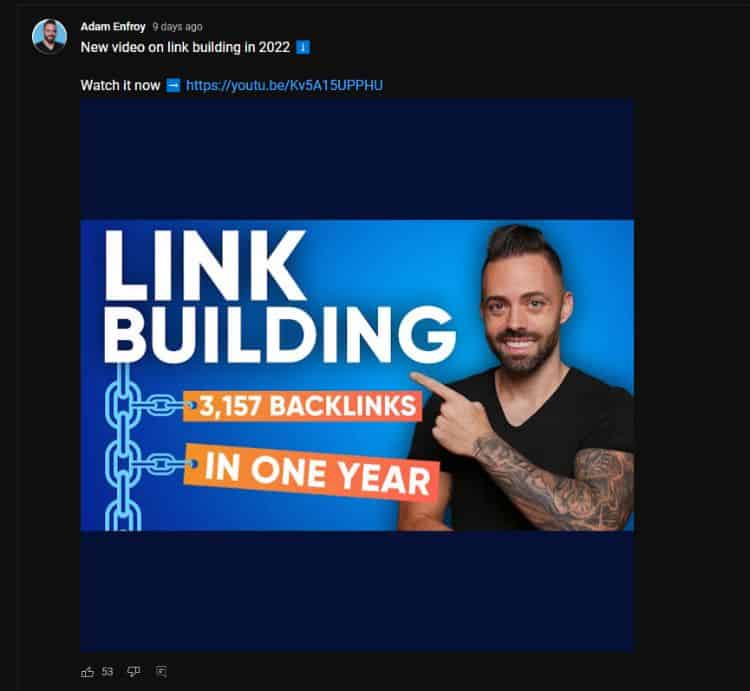
Starting a YouTube channel is a long-term commitment, not only in the sense that you have to continue uploading new videos but also in terms of coming up with quality content for your viewers.
This might also change as time goes by so keeping your finger on the pulse is crucial to your channel’s success.
Creating Engaging Thumbnails
A good thumbnail image is essential for getting people’s attention when browsing through YouTube (or even Google) search results.
The right thumbnail helps potential viewers visualize what your video is about, so it stands out and gets more views than competing videos.
Also, having a pattern interrupt in your thumbnail will force people to stop and pay attention.
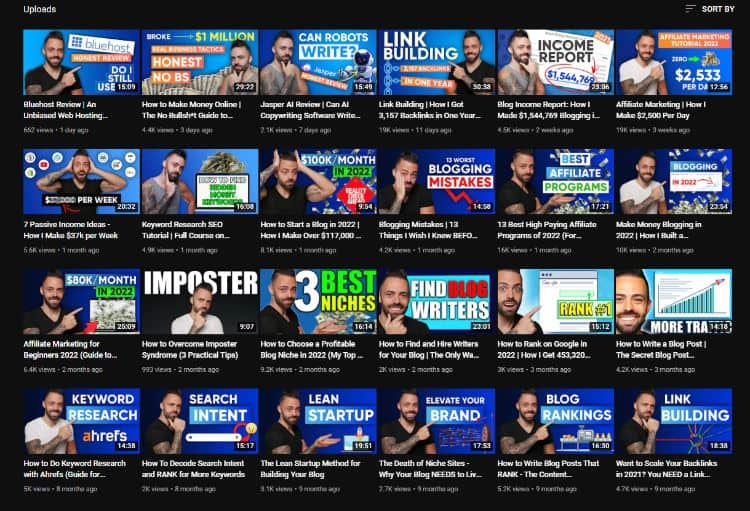
Whether it’s using giant, bold letters to announce video topics or weird images that get people’s attention, you want to keep in mind that having a thumbnail with some “teaser” will increase the number of views on your video.
Subscriber magnetism
Having a large subscriber base is vital to get more people watching your videos and increasing your earnings – whether it’s through YouTube or other products you sell through links in your description.
However, there are some things you can do to make it easier for viewers to subscribe while also maintaining a solid viewer base.
If you have many videos under your belt, have a branding scheme where all of them link back to the same channel.
In this way, if one video gets popular, you can easily add links from other popular videos, so more people subscribe.
It would help if you also created incentives for subscribing by doing things like weekly giveaways where you give away something related to your channel.
It could be a product or service that only people who subscribe can win, or it could simply be an in-game item in one of your video games (if that is your niche).
Simply encouraging users to subscribe to your videos to be informed when you release new ones still works but having a better incentive will yield improved results.
Whatever the case may be, creating unique and engaging incentives can help you maintain a subscriber base while keeping viewers coming back for more.
Other strategies that allow you to earn passive income, which are not mentioned in this article include:
- renting out a spare room to renters on Airbnb
- creating a t-shirts small business with a small upfront investment
- installing vending machines
- doing retail arbitrage on eBay (might have some active income elements depending on how you look at it).
Passive Income Ideas: Summing It Up.
To make passive income, you need to work hard now to increase your cash flow later.
It’s a two-stage approach:
- Create a digital business to increase your cash flow.
- Take your excess passive income from your ditial business and invest it further to create more passive income.
A lot of people ask: Can You Create Passive Income with No Money?
Yes, you can start a business with no money – it’s going to require more effort from you, but it’s still possible. Take a look at people making money on Amazon FBA for as little as $39.99/month.
When it comes to Amazon, there are also plenty of other side hustles to consider.
Again, my favorite strategy is to start a WordPress blog with Bluehost for just $2.95/month.
This is the path to passive income that I took:
- Start a blog and sell high-end consulting services.
- In the beginning, focus exclusively on building up your blog’s Domain Authority (DA) with guest posts and link building.
- Begin adding affiliate links to your site.
- Once your email list grows to a suitable level, sell a product or online course to your audience.
- Once you’re at 50k visitors/month, begin ads and sponsored content on your site.
- Go from 80:20 consulting/passive income to 50:50, 20:80, and finally 100% passive income.
- Take this passive income and invest it in stocks, index funds, and real estate.
And remember – no time will ever be perfect to start.
So just start now.
Your journey of passive income generation only begins when you take the first step.
Whether you’re a seasoned investor building rental income or a teenager growing your YouTube channel, you can make money online and build passive income.
In the end, there’s no get-rich-quick scheme. While passive income is feasible, it takes hard work, smart strategies, and determination to get there.
Recommended Reading on AdamEnfroy.com: To continue your path to passive income, check out my ultimate guides on how to start a blog, the best affiliate programs, and the best low-cost, online business ideas to start this year.






Awesome steps for a Passive Income thanks for sharing this article
I appreciate your post Thanks for uploading this blog Please Keep posting
Very Helpful Information, I like it Very Much.. Thanks for this post
Hii
Thanks for sharing and commenting
Good passive income Tricks,
Lot Thanks!!!
Very Informative Post..Thanks…!!!
this is extremely helpful info !!Thank you for giving information…
This is the most helpful information I have seen on starting a blog the right way. Most blogs just say start blogging, but it is really not that simple. I appreciate the screenshots of your performance over time!
This article is very good explaining how to make a passive income from a blog. No wonders everyone wants to create their blog these days and make money easily, but blogging is not easy at all, in fact, require a lot of work, more than a normal job.